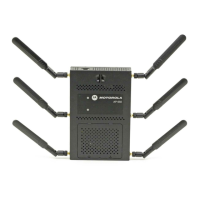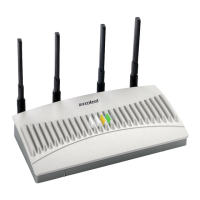Profile Configuration
7-9
7. Define the following Switching Mode parameters to apply to the Ethernet port configuration:
Speed Select the speed at which the port can receive and transmit the data. Select
either 10 Mbps, 100 Mbps, 1000 Mbps. Select either of these options to
establish a 10, 100 or 1000 Mbps data transfer rate for the selected half duplex
or full duplex transmission over the port. These options are not available if
Auto is selected. Select Automatic to enable the port to automatically
exchange information about data transmission speed and duplex capabilities.
Auto negotiation is helpful when in an environment where different devices
are connected and disconnected on a regular basis. Automatic is the default
setting.
Duplex Select either half, full or automatic as the duplex option. Select Half duplex to
send data over the port, then immediately receive data from the same direction
in which the data was transmitted. Like a full-duplex transmission, a half-
duplex transmission can carry data in both directions, just not at the same
time. Select Full duplex to transmit data to and from the port at the same time.
Using full duplex, the port can send data while receiving data as well. Select
Automatic to enable to the Access Point to dynamically duplex as port
performance needs dictate. Automatic is the default setting.
Cisco Discover
Protocol Receive
Select the radio button to allow the Cisco discovery protocol for receiving data
on this port.
Cisco Discover
Protocol Transmit
Select the radio button to allow the Cisco discovery protocol for transmitting
data on this port.
Link Layer Discovery
Protocol Receive
Select this option to snoop LLDP on this port. The default setting is enabled.
Link Layer Discovery
Protocol Transmit
Select this option to transmit LLDP PDUs on thisn port. The default setting is
disabled.
Mode Select either the Access or Trunk radio button to set the VLAN switching mode
over the port. If Access is selected, the port accepts packets only form the
native VLANs. Frames are forwarded out the port untagged with no 802.1Q
header. All frames received on the port are expected as untagged and are
mapped to the native VLAN. If the mode is set to Trunk, the port allows packets
from a list of VLANs you add to the trunk. A port configured as Trunk supports
multiple 802.1Q tagged VLANs and one Native VLAN which can be tagged or
untagged. Access is the default mode.
Native VLAN Use the spinner control to define a numerical Native VLAN ID between 1 -
4094. The native VLAN allows an Ethernet device to associate untagged
frames to a VLAN when no 802.1Q frame is included in the frame. Additionally,
the native VLAN is the VLAN which untagged traffic will be directed over when
using a port in trunk mode. The default VLAN is 1.

